Archive for the ‘Aurelia’ Category
Rethinking creativity
Historians divide Lancia’s history into phases – which typically follow ownership of the company: first the family, then next under Pesenti, ending with Fiat ownership from the end of the 1960’s..
The family phase of early ownership can be simply divided from first under Vincenzo, Adele’s stewardship and of course the memorable post-war years under Gianni. The Vincenzo phase becomes two: pre- Lambda, more classic, and then post-Lambda, more radical, ending with the Aprilia.
The Pesenti phase, from 1955 to 1969, often languishes in the shadow of the earlier family ownership, and as a passage to later corporate ownership. But it might be worthwhile to consider it as an interesting interlude in the company’s renovation, one where good ideas, more contemporary production practices, and a beneficial owner was trying to continue the role of Lancia in a new world.
With a different understanding of this phase, one could then consider Lancia’s history more simply as two parts, one phase first under family ownership and then under Pesenti, but sharing the role of a small industrial concern (through to 1969). Later, the second phase of Lancia would be under Fiat as a corporate concern of particular distinction, but clearly no longer personal.
This suggests a different way to think about Lancia’s evolution. Rather than dividing the company into family ownership, and then not, it suggests that one could look at the company first as run personally and then merely as part of a much larger corporate enterprise.
What would be gained by such a shift in perspective? Well, one thing would be that our focus would be less on the personal innovation in the company (always alluring) and more on its role in the marketplace. The self-sufficient company, one before Fiat, approached its market in one way; the one after Fiat ownership approached it differently – as part of a larger corporate strategy, still seeking to engage the same niche, but with different tools. Could one really approach the design-oriented professionals with a conventionally engined car, as Fiat proposed?
Any company respecting its history must find ways to evolve. And the evolution is problematic – this difficulty exists for similar companies in other areas: consider Leica, or haute couteur clothing manufacturers, or even professional design and engineering firms.
All struggle with reinventing themselves. Many have had similar transitions from family to corporate ownership, and this has never been easy. There just seems to be no simple successful way to do this. Recent hIstory is full of complicated examples of firms trying this. Leica, inventor of the 35 mm rangefinder camera, has struggled mightily in the past 25 years to develop other cameras of equal merit. Their optical divisions (instruments, sport optics) have done well, but their camera group seems caught between updated rangefinders (now digital) and more cutting edge, but not traditional, DSLR products. All built to very high standards, but their client base has been slow to accept newly designed high priced alternatives to the work of larger Japanese companies. So companies like Leica are stuck between the proverbial rock and a hard place: if they leave their past behind, they lose their customer base; if they don’t evolve, they are mired in their (no longer profitable) past. This seems to be the fate of companies with a strong historical identity.
Let us return to Pesenti and the period from 1955 to 1969: could one see this as a rather interesting period of evolution – not just with different ownership, but as a continuous grappling for how best to deal with Lancia’s strong history and company tradition? Seen even a bit more broadly, one could look at the 25 years from 1955 to 1980 at Lancia, and see them as a period where the past was still vital, but as a period when Lancia went through changes to evolve into a more contemporary, corporate model.
During this period, there must have been still remaining strong and clear memories of the period of family ownership. Many people from that phase of ownership were probably still involved in the company – and many were forced out.
It is interesting to look at the Pesenti, and early Fiat years as the transitional period it was: the Flaminia was derived from the Aurelia; the Flavia was clearly Fessia’s effort to contribute to Lancia’s heritage with his “radical Lancia”. The Fulvia was derived from the Flavia in the same was as the Artena, Ardea and Appia were from their big sisters. it was done with some assistance (still unclear) of Zaccone Mina with the return to the V engine. Of all of these, the Fulvia was the most original contribution to Lancia’s heritage – although the Flavia may have been just as significant in engineering terms.
These models are distinct efforts to reinterpret and carry forward the Lancia heritage. So too, the factory’s expansion at Chivasso can be seen as Pesenti’s effort to develop a modern Lancia, with high standards but more efficient production values. Long overdue, he was probably quite correct in this, but ultimately ended up with the curious dillemma of neither enough and too much production at the same time.
Pesenti’s efforts to change the scale of Lancia production could not save the company. Was there still insufficient volume to justify the costs? Or was the problem simply not enough sales volume in the troubled 1960’s? Ironically, in looking at Gianni’s sale of the company in 1955, one must also recognize that Pesenti’s efforts over the next 14 years, with all the funds he put into the company, were also not sufficient to make it work.
In looking at the complex systems of design and innovation at Lancia, I have wondered if the problem was not in the approach of lancia, as is commonly thought – but rather in the fact that the financial control systems in place were not adequate to manage the very complex production model. Imagine the Pesenti model of design and production today – nimble, small scale, innovative and highly adaptable prodution – it would be highly desirable, an Italian Audi or BMW. It is quite risky and difficult. Very few companies have survived with a small or medium sized factory and highly variable complex designs. Maybe there are a few….
How to place the company in the marketplace became the next struggle. Surely the Beta has its role in this, and the evolution of the Delta is remarkable. As paths for repositioning the company in a different role, they are fascinating examples of how to evolve a brand.
And then the Stratos – conceived from out-of-house, it has little initial Lancia heritage, until nursed to production by Cesare Fiorio, whose father a senior Lancista from years before. Small strands of continuity are evident in this revitalizing Lancia by appealing to autosport – these efforts are a renewal of the “Gianni gamble” (where sport was to be used to give Lancia identity), but this time it worked. Building on the sporting successes of the Fulvia, the Stratos dominated the rally world and the press. Succeeded by the Delta, these three cars redefine Lancia for the next generation. The company is reinvented once again.
The Delta successfully connects with aspects of the Lancia past. This car is a small, upmarket design-focused product like many earlier Lancias – but now without radical engineering, but with a focus on the market. Can one see the Delta as a Lancia meld of an Aprilia and an Audi A3? Lancia DNA was once again revitalized. The Integrale is the sport model, a B20 of its time; race product built from a standard car.
Today, memory and knowledge of the original Lancia heritage has long left the company. The company now must turn to some other way to find its roots. Mike Robinson started this work – in his efforts to find a legacy now much more obscure and dificult to understand. Today’s generation builds off work and heritage from the 1980’s, not the 1950’s or earlier.
And the innovative Lancias of the first phase, from 1920’s the 1930’s, through to the 1950’s and 1960’s? These cars are tucked further back in history, where the explorations and innovations are more distant. Peculiarly, they may emerge more distinctly – in simpler times, the more accessible engineering make them shine clearer. One can only hope so. Amdist the clarity of the Lambda and the Aprilia there is much inspiration.
drawing from Lambda Owner’s manual
Roesch Talbots
"Georges Roesch And The Invincible Talbot” (Grenville Publishing, 1970), makes one consider another set of fine engineering ideals.
Georges Roesch was a Swiss engineer, who worked for Talbot in London from 1925 through the late 1930’s. He had been sent to Talbot by Coatelen (Sunbeam, Paris) where he proceeded to turn Talbot around until the successful company was sold off in 1935. The Talbot name was then used in Paris by Anthony Lago, who made different cars through the 1950’s.
The English Roesch Talbots of the 1930’s were known for refinement, sophistication and flawless performance. They were superb large luxury touring cars. In competition they ran as touring cars, frequently against more specialized race cars. The Talbots were remarkable for their sheer reliability. Their performance was staggering: Blight writes of many races (such as long 500 mile Brooklands runs at high speed, 6 day Alpine Cups,etc. ) where Roesch Talbots ran quickly, silently, and needing no work, running without stopping. Rather remarkably, these 4 seater touring cars had little special race preparation and yet were in the same league as racing Bentleys, Alfa 2.3, and the Bugattis. Roesch was quite stubborn in his development, and even getting aquick cahnge gas cap fited took a year or two of negotiation. Getting Roesch to fit even adjustable radiator shutters took long negotiations, so these were not cars compromised for competition. But they ran for hours upon end, often fitted with large gas tanks and not even stopping for gas.
Theirs is an incredible history – full of 2nds and 3rd place finishes. We know little of this because of two reasons: first is our fascination with specialty race cars above all else, and the cars that “cross bred” between touring and race seem compromised. That they may actually have been a better product is hard for the enthusiast to realize. Secondly, Talbots were caught in the period of transition from touring cars racing competitively to competition only for purebred race cars. They raced with the Bugattis and Alfas, but often found themselves “finishing” behind slower (and smaller) cars, such as blown MG’s due to handicapping regulations, in fashion at this time.
This history is not a “if you only look at this small slice, our car was so special…”, so current today. They were one of the few cars that successful ran over 120 mph in the upper course of Brooklands (a Bugatti, 2.3 Alfa, and a racing 4.5 Bentley made it as well, but only the Bentley was as durable as the Talbot). With a team of three cars, they won the Alpine Cup (6 day race) twice, running together without breakdowns or issues, even finishing once losing no marks whatsoever. They drove these cars to the races, ran them, drove home, never even adjusting their brakes! They once ran a car in the Mille Miglia, running close to the top until crashing in the last hour from fatigue (looking for the promised, yet absent fuel in Rome took its toll on the drivers, while the Italians got much needed rest…).
So what happened? Throughout the 1930’s, amidst the depression, Talbot grew as the successful part of the ill-fated and under-funded corporate conglomerate of STD (Sunbeam Talbot Darracq). They were neither supported nor embraced by the financiers of the parent company, and were rudely sold off to pay down debt to Rootes in 1935. They proceeded to dumb down the engineering (anybody remember Humber?), dismantling the engineering and manufacturing team in the process. Lost were Roesch’s other fine inventions, including a production pre-selector gearbox (early automatic), installed in quite a few cars successfully. His experimental high-revving straight 8 and fully independent suspension chassis (around the time of the Aprilia) were never put into production either. Rather, his reputation has to rest with the remarkable straight 6 engines made and run without fault at performance levels not achieved by others.
And what was Roesch’s genius? It was the first major example of the discipline of refinement – with exquisite engineering, he tweaked to perfection the basic parts of the motor without drama, without excess. He achieved his success by focusing on the reciprocating parts to be made strong and light, at levels not seen before. He made a very light pushrod-driven valve train, with reduced wear, allowing high revving motors (5000 rpm plus, even with long strokes). His lower-end crankshaft design was more robustly sized and better balanced to allow higher revving without failures, and his superb detailing of pistons and conrods provided less weight and thus less strain. For example – his reciprocating weight (a piston and rod) was about 630 grams (2/3 that of the 3.4 Jaguar made from 1948-1968, and equal to that of the Aurelia 2.5 liter motor of smaller bore). The Jag had difficulties revving over 5,000 rpm – but not the Roesch Talbot. Roesch’s genius was focus: lessen weight, improve performance, and thus have high revving, cool running, high compression (starting at 8:1, eventually working up to over 10.5:1), yet totally faultless and reliable cars.
The performance numbers proved this – his these 3 liter engines, driven to races far away, Le Mans, Ulster, etc., were used for hours (or days) revving to 5,000 rpm (last versions even up to 6,000 rpm) for hours on end without trouble, and then were casually driven home. And never breaking, silently running.
in the realm of the auto, the sexy ones capture the imagination. But as Blight points out, Bugatti used basically vintage WW1 era technology, and yet his work was called radical. On the other hand, Roesch’s work set forth the precision engineering principles that remain at the roots of cars today. This work remains mostly overlooked but buried in English history is this offshoot, worthy of deeper consideration.

What lubricants?
What is the right oil to use? This is a moving target, as oils were changing throughout the 1950’s, and the factory was changing their specifications along with them. Determining what lubricant to use is yet another glimpse into the world of Lancia and the motoring industry in the 1950’s. First step is to figure out what was Lancia recommending for their cars. It turns out this was a specification in evolution. So where to look? For the Aurelia, a review of Lancia’s Owner’s Manuals shows thinking in the 1950’s. Then Lancia published a data sheet for lubrication, # 1027I, in 1965, reflects their conclusions ten years later.
These are summarized here: spread sheet of the different Aurelia lubricants
Three Owners Manuals were reviewed – from 1952, 1956 and 1958 in the spread sheet above. The 1952 manual covers the B10, B21, B22 and B20 2nd series, and represents early thinking for the Aurelias. The 1956 manual, is a 5th series manual, with an English insert for the 4th series, and represents “mid-course” thinking. The 1958 manual is for the 6th series. The final chapter of Lancia’s thinking can be found in the 1965 Data Sheet. The evolution is as follows:
- Engine – the 1952 manual called for straight weight oil by Veedol, with different weights depending on outside temperature. 20, 30 or 40w were used. Curiously, from 1952 to 1956, Lancia recommended 50w oil for “sporting events”, probably in response to engine heat. By 1958, this is no longer mentioned for the 6th series cars. By 1954, 10-30w multi-grade oil from Mobil is accepted for use and by 1958, Esso multigrade. By 1965, Lancia only recommended multi-grade; straight weight oil is dropped.
- Transmission – throughout the Aurelia’s lifespan, Lancia called for use of 90 weight (EP) oil. However, curiously in the 4th series, 140w oil is called for the transaxle and potjoints when outside temperatures were over 68 degrees. Why is not clear. Was this because of wear in the pot joints? By 1958, this approach is dropped, and 250w oil was called for the potjoints only. They gave up the idea of changing transaxle oil for higher outside temperatures.
- Steering box – 140 w oil is recommended throughout.
- Front Suspension – typically 20w oil is recommended for the refilling, however, the specification for the bottom is changed frequently: originally to be filled with 30w, it is later changed to 50w, then 40w, and finally 90w (EP).
These changes evidence Lancia’s responses to changes in oil technology, as well as their efforts to address wear in certain areas. Note the move towards simplicity, as earlier efforts to be more “specific” and changing oil for particular uses (temperature or competition related) are abandoned in favor of simpler, more comprehensible specifications.
The 1950’s were a period of significant change in manufacturing and in the lubricant industry. Lancia (and other manufacturers) found wear to be of concern as the impacts of higher continual speeds (autoroute driving) were likely more in evidence.. Oil formulations were being changed by the oil industry, in moves from single weight oils to multi-grades andadditives. With the Aurelia, Lancia was changing to keep up with the times.
Torsional Rigidity
One of Lancia genetic threads is superior chassis design. Not only with regard to suspension, but also chassis stiffness. A brief review of Wim de Weernink’s La Lancia provided data, and thus a summary could be prepared.
What is torsional rigidity? Its the ability of an object (the car chassis or unit body) to resist torsion or twist. It is measured very simply: one end of the car (typ. front suspension mounts) is held fixed. Attached to the other end is a long bar, running either along the axle position or close to it. The bar is loaded with weight at a given distance, providing a moment arm. The amount of twist in degrees is then measured against the moment arm ( in ft lbs or Newton meters).
In Lancia’s early years, this was measured with a fixed moment arm (125 Kgm), and a measured amount of twist (in degrees or minutes). Nowadays one measures the amount of moment (typically Newton meters) to achieve one degree of twist. A chart converting their measurements is provided below, along with contemporary comparables. One can see Lancia’s engineering progress and how good they were:
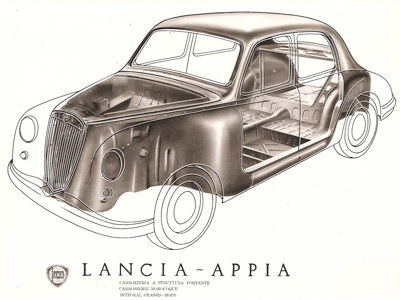
This confirms what was always suspected – Lancias were way ahead of their time – Wim mentions that comparables at the time of the Lambda were 10 times more flexible; there is notable progress in the Dilambda with one years work making it 130% more stiff; the Augusta and Aprilia were clearly successful and their stiffness is sufficient today. Take a look:
Keep in mind the Lancia numbers were some 50 years earlier.An Aprilia is equal to a Dodge Viper.
Lancia clearly understood chassis stiffness, and that corporate intelligence, even though not widely documented so far, rested within the company and showed up in the later cars as well. Thus there are Appias without rattles and Fulvias without chassis flex.Today’s production values are remarkably close to the Aprilia of 70 years ago. Progress has been made – note convertibles like the Lotus Elise are very stiff now even without enclosed framing. Anyone up for a visit to an engineering library (not much on the web) to learn more about comparables?
Lancia was way ahead of the pack. They look pretty good even today.
Motor Apart
The last motoring entry was an October report of oil pressure loss and a knock from the motor. Since then, the motor has been taken apart, and its clear: the rod bearings had begun to fail and fall apart. There was separation (delamination) of the babbit from the mounting shell.
What is babbit? According to Websters:
of tin, lead, copper, and antimony, used to reduce friction in bearings, developed by US inventor Isaac Babbit in 1839.
By itself, it works well, but the main issue is the connection to the shells. To get good adhesion, the bronze shell is lined with tin, and then the babbit poured directly on the tin and either machined or hand scraped.
The layer of tin adds yet another thermal barrier and this can add to the possibility of separation. To address this, vintage race cars had the babbit poured directly in the cap or conrod: one less connection to go bad. The reason for the shell is serviceability: shells could be replaced readily, whereas a direct pour into the rod or block would require careful line boring or machining. Thin shell bearings are the next generation.
The babbit had been poured into the shells some many years ago, and we never knew its source. It looked very fresh upon inspection. It dated from the 1960’s and had been matched to a reground crankshaft.
There are two ways to test the bond of the babbit to the shell: the old school way is by the “ding” test – where the shell is hung up and tapped: if good, one hears a clear sound, and if not, a dull sound. There is said to be some ultrasound testing now available, unknown then.
Another issue is the thickness of the babbit. General understanding is that it should be about .5 mm thick – and the babbit in this motor was about 1 mm thick. There is a loss of strength in the white metal when it is thicker, but it is not clear if this was excessive.
The babbit was separating from the shells, not just on the one conrod, but on all. These pieces floating around the engine did no good, so there is some serious work ahead.
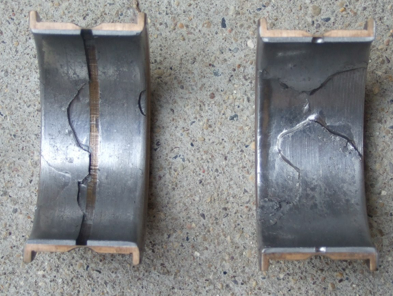

Parts Books
from the 1959 book, introducing the B20.
typical illustrations – just gorgeous.
the 1954 book, for all the early cars (credit: Huib CD’s)
first book, from 1951 (credit: Huib CD’s)
We like our cars, but the Lancista gets really excited about their parts books. There, in full detail, Lancia told the story of the car in illustrated wonder. All the parts to the car are shown there, but there is more, lots more.
First, there is the assembly notion – the parts book actually shows how the cars go together. All the little bits, and even sometimes you can get a sense of sequence, surely of purpose for all the parts.
Second, there are the wonderful illustrations in the parts books. Done by a man named U. Ciompi, who is rumored to be a friend of the family and a wonderful illustrator. I seem to recall a story in Viva Lancia about him years ago. Anyone have a copy?
The book is typically divided into sections, each for a model, starting always with the Berlina, then special sedans or chassis, the B20, and finally the open cars. After the Berlina, each section typically has only text pages noting the changed elements, unless the change was significant enough to warrant a new illustration. Hunting between text changes on the B20 (for example) and the illustration of the application on a Berlina can be a workout at times!
The details on each Tav (sheet) of the parts book tell when the part was replaced or changed – typically by serial number, and sometimes by engine number. These records are quite meticulous, and for the Aurelia owner in the midst of winter, serve to pass the time, as they ponder what changes happened when and for what reason. Those of you in warmer climes are driving your cars instead.
The origin number indicates when the part first came into being – typically 800 for B10, and 803 for B20, but there are some surprises – some parts comve from Appias, Ardeas or Aprilias, or even trucks.
There are some other wonderful bits to be found – sometimes, Lancia would give an assembly number, each part number, and a casting number as well. Careful scrutiny can lead to more mysteries (7 different engine block castings, for example).
Where to get one of these wonders? Sometimes they show up on Ebay, and are not cheap. The easiest way is to get the CD from Huib, which has several on disk already.
Finally, how many of them are there? Well, its a bit unclear as of yet. The first parts book is from 1951, and the definitive one for the early cars is called a second edition, dated January 1954. It uses the old parts numbers, far more friendly and intimate than the later numbers.
For the second series cars (Berlinas), such as the B12, later B20 and B24’s, the parts book is again issued as the second edition, dated August of 1959.
Typically, the 1959 book is used on the later cars and replaces the earlier one entirely. One does not need to go back and forth. Just for fun, the tav numbers in the second edition are one off from the earlier edition.
How many were there? We know of:
a) 1951 – for B10, B50, B51
1954 – for B10, B10S, B50-53, B21 and B21S, B20 through s. 3, B15 and B15S, B22 and B22 S
1959 – for B12, GT 2500 (B20 s.4-6), Spider,convertible.
This has the new part numbers and the cross-index to the old ones. It does not include the earlier cars, tho.
I have a very early parts book, still in draft form, from September of 1950. Its titled: “Distinta provvisoria”, and is without illustrations. Curiously, the tav for the carburetors is not included, to be developed later. Looking through this book without illustrations, one can see that the part numbers on each Tav (starting with 1, and going up) are not assigned by any magic formula – but rather simply alphabetically! Took years to find that out!
Also, a 1956 parts book has been seen. It has all illustrations first, and then the text pages, and covers the B12, B20’s to s. 6, and the B24’s. Curiously, it has all the old part numbers. They must have been just getting around to changing them then.
If anyone has a 1951 or 1956 Parts book, or any of the supplements (like 1953) they’d like to part with, I’d be interested in hearing from them. A 1959 book in trade?


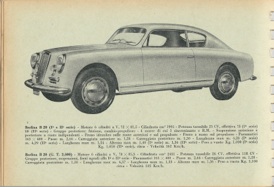
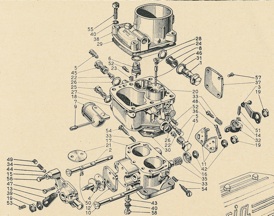
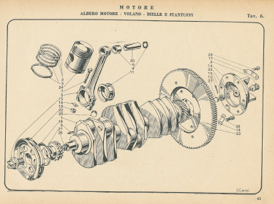
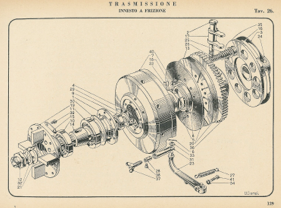
Tradition considered
Lancia has always involved tradition, but in a rather thoughtful way. Tradition suggests continuity, but how do you have radical innovation continuously? Seems a bit odd. That is the problem they had to solve, c. 1950.
The announcement of the Aurelia was the moment for Gianni’s first new Lancia. Imagine the time, and the pressures: the new car was radically different from the old, not just in terms of engine configuration, but also in terms of complexity. It was the first new Lancia not developed under Vincenzo (leaving aside the Ardea). It was important that it be placed comfortably in the context of the company’s work to date and show how the past would be taken forward. This was also the new Italy, after the war, and Lancia was to help lead automotive design and production for this new society.
These conflicting goals must have caused the company’s publicists some moments of deep reflection, as they endeavored to resolve these opposing issues. Such moments are now not unfamiliar to the Lancia buff: consider some 10 years later, with Fessia and the Flavia, among others, but in 1950, this was new ground to be broken.
With the Aurelia, Lancia published the small booklet, “Presenting the Aurelia”. In this document, the company confronted this dilemma thoroughly in text. An English version exists – mine is stamped in ink on the back cover “2 Aug 1952”, but was perhaps published sooner. I assume it was the same language as the Italian version and with a factory translation. The quality of the language is superior to the rough translations that sometimes appear in Italian sales literature or owner’s manuals. This piece has truly superior writing. It is worth looking at in detail, as there are interesting observations on the roles and conflicts of progress and tradition. The booklet starts out addressing these issues directly:
“With the appearance on the market of the new Lancia “AURELIA” there is one particularly interested aspect to be noted: the co-existence in the Lancia Company’s intentions and plans of a great desire for progress side by side with an unfailing attachment to tradition. This is not actually a contradiction, because on the the characteristics of Lancia has always been to maintain their position in the forefront of international technical developments while preserving their own individual style”.
In short, Lancia recognized that progress and tradition normally are at odds, but suggests that there is a way to solve this:
“This is the reason for Lancia’s pre-eminence as, fortified by their past experience and knowing their own possibilities, they have always been both daring and conservative. …. Nothing that has been introduced by Lancia has ever been discarded once put into production: their models have remained on the market for years because the innovations and inventions have been fundamental steps toward the practical realization of positive and new requirements of modern motoring”.
Both daring and conservative…. Lancia states that these are reconciled, with new and positive progress. Seems as if belief in scientific progress can resolve the old and the new. How can this be?
“The Lancia tradition, being founded on sound principles and foresight, innovations that to many people seemed unorthodox were, and still are, for the Lancia Company, simply logical developments of fundamental principles.
Traditions in themselves are a source of strength only if they are good ones, able to to stand the course of time without becoming outdistanced by progress: Lancia traditions have never become crystallised into past history but have always represented an active and far-seeing evolution.”
They tell us that traditions are founded on principles, that innovations are logical developments, and that progress is evolution. Lancia is safe in their thinking, they only progress when it is right to do so. They then go on to affirm this with a reach back to their longevity and continuity. Its an interesting argument, to be sure:
“If, therefore, something new is announced, it follows that the greatest interest is aroused in the public, who know that when Lancia, without abandoning their principles, introduce some technical innovation they do so in the absolute certainty that by grafting the new on to the traditional, there will be no risk of withdrawals, false starts or experiments.”
While this is a slippery rhetorical argument, it does have soe credence. This established, they then note that in these new times, the agenda has changed somewhat. The Aurelia now has to meet new concerns, with both Italian and foreign demand for roomier and more comfortable car, still with Lancia characteristics of light weight, responsiveness, acceleration, speed and low petrol consumptions.
resolved it brilliantly….”), and that meeting these modern demands solves both new and old agendas.
Thus, the use of independent rear suspension, the 6 cylinder motor (still with a V-form, compactness and balance), gearbox and clutch to the rear of the chassis – saving space, and making more room inside.
So far as appearance is concerned Lancia have a particular attachment to Italian body style which they did not want to abandon, but, in the this too, they have for the first time departed from their typically simple and almost severe style, and have softened the body line with subtle curves suggested by the highest standards of traditional Italian coachwork.”
They departed from the simple and severe style…. with subtle curves, within the highest standards of traditional Italian coachwork, even with their particular attachment to a style…. All the pieces are there to make a full argument. This may be one of the less convincing parts of the brief, but it is delightful in the reading. One can almost see them trying to work this all out.
But in the end, some interesting principles are at work overall. The Lancia DNA has been declared – it is both conservative and progressive, and the work of Lancia is to reconcile the old and the new. This new product is surely part of the family.
Ironically, the new Aurelia would redefine the company, and change the picture far more than anyone ever imagined in 1950. The next twenty years would produce many more changes in the path of Lancia. This brief moment, seemingly so radical at the time, would just be one event among many changes.



Booklet and first three pages
(scan courtesy of Huib)
Nardi and Lancia
Enrico Nardi was an interesting man. He had many skills, among them, he was a tuner of performance cars, and later a manufacturer of wooden steering wheels. Post WW2, he set up shop as a purveyor of modifications to make your car go faster. From about 1948 through the 1960’s, he had his own shop, offering modifications to Lancias and other cars. He also offered his own race car (ND 750), and made a few specialized one-offs in the 1950’s, such as the two Lancia Blue-Rays among others.
Before he became mostly known for his wooden wheels, his work was mostly providing carburetor kits and other hotter setups for many post-war cars. For Lancias, he offered these kits for Aprilias, Ardeas, and Aurelias. He also tuned Appias, and later Flaminias and Flavias.
For the Aurelias, Nardi offered performance modifications for the different motors, including additional carburetor configurations. These varied over the years, as he offered a conversion for 6 single barrel dell’Orto carbs, and also a more moderate two double barrel Solexes (on the B10 and 2 liter motors). By the time of the 2.5 liter motor, Nardi offered the setup most widely known of two double barrel Webers, as referenced in the price list above from 1955.
These conversions included the manifold setup (from one to three castings, depending), probably the carburetors and linkage, and the air intake, typically cast aluminum on the Lancias.
He may well have offered other modifications – it is rumored he offered thinner gaskets, altho he may have cut the heads instead. Early promotional literature for Nardi (c. 1951-1952) shows different levels of modification, depending on the compression, but it isn’t clear how that was achieved. He also offered his special Nardi cam, which he probably installed for you at his shop.
Documentation is very hard to find. There is a complete brochure on Nardi modifications offered for Appias, but the Aurelia information is much scarcer. But images from his promotional literature can be seen here.
Wikipedia (if it is to be trusted) gives us the following facts on his career:
.
The relationship of Nardi to the factory remains of interest.. Was he just a tuner, friend of the factory? Or was there a closer interaction – perhaps Nardi acted as an “out of house” tuning consultant? The references in Wikipedia are curious: Nardi as employee of the factory, and then “advisor” to Vincenzo? One wonders what a 29 year old Enrico was telling Vincenzo at the latest in 1936? Perhaps: “Faster, please?”
While the facts lie in the past, some parts we can try to piece together. two places to look – first, the 4C Aurelia manifold. In Wim Oude Weernink’s La Lancia, he makes reference to a 4C Aurelia manifold. In the early first edition, there is a photo of it, and it is noted that it was used by both factory competition use, and later by Nardi in his aborted Lancia F2 car. A careful look at an image of the Nardi F2 car confirms its use. This manifold was special, having the four single barrels Webers similar to those used on the Aurelia, but they can be seen with their slightly different base, using probably the 32 DR 8 SP used on Fiats. These were probably selected to make them fit, very similar as used on Aurelias. A peek at an image of the Nardi F2 car confirms the same setup. While there may have been more than one, clearly, there is friendly communication between Nardi and factory race effort.
One other place to look for collaboration- in the small Nardi book put out some years ago, there is reference to Nardi modifications to the B20 car of Bracco in the 1951 MM. Lancia folklore has always suggested that the car was not seriously modified, but closer to stock. Which was correct?
A photo of the engine in Ippocampo’s sixth place car from the MM shows use of the two Solex setup; de Virgilio’s notes reference use of a Nardi manifold on Bracco’s motor. Even then, Nardi was providing manifolds to the factory. One tends to think the relationship was pretty close then for the factory to use a Nardi manifold. Perhaps others who know more of this would be willing to comment?
Finally, a return to the book, La Lancia, by Wim de Weernink, now in three editions. Most of this is covered in this book, and so far, always correctly. One must express thanks to Wim for his impeccable research done so many years ago. Even today, his work shows us where to go and look, and sets high standards that remain hard to meet.
Up days, down days
As has been said before, without down days, there would be no up days. And now we are into deep fall weather, and heading toward Thanksgiving and winter. Not good car time in the midwest, to be sure.
There are a few not-so-cheery items: the passing of both Scott Taylor and Gary Byrd (in California) have caused pause in the realm of cars; the B20 needs its engine taken apart this winter, and the weather is no friend to open cars either. The recent economic tumble has taken some luster off the old car hobby, as well. There seems to be an introduction of sobriety into all of this.
All is not grim – while the economy has been stalling, the American electorate has made a good choice. Chicago is in many ways both a small and big town, and it is possible to know some of these people first hand. It is nice to see David Axelrod (who was a classmate in college, and whose office is a block from mine) do so well, as he is a very straight-up thoughtful kind of guy. He and the others are a refreshing change from the dark side we’ve had far too long.
So now is a time to settle down and examine what one has. Work on Aurelia material goes on. I’ve located some lovely early Nardi and Lancia advertisments from the 1950’s – it seems that Lancia was more active in its graphics for a period c. 1953 than we might imagine. While we are a long way from that time, there are still lessons to learn.
Wishing everyone good health, happy motoring and buono fortuna.


Pennsylvania
the Reunion
The B20 left from Chicago to the East Coast Lancia reunion in northern Pennsylvania on a Thursday afternoon. Tony Nicosia came to Chicago to join me on the long drive east. One day to cross Indiana and Ohio, and a second day across Pennsylvania. About 300 miles a day is the max in the car, which ran superbly.
We met the Lancia 6 folks Friday night in Wellsboro, PA, on the northern border, midstate, about 40 miles south of Watkins Glen, in beautiful hilly countryside. Saturday was spent with a glorious wild run through the country – arranged by the East Coast VP and host, Walt Spak. He found some tight roads. That afternoon, some drove north to the Corning Glass Museum and saw an amazing collection of glass – from old Roman bottles 18” high to incredible 18th and 19th c. excesses and delicate pieces. Recent examples of experimental glasswork were also compelling – most compelling exhibition of glass I’ve ever seen, and well worth the trip for that alone.
This reunion was also special as it had members of both the east and west coasts – rarely seen. From the east, Armand and Shirley de Gigilo, Mike and Mike Kristick, Walt, Mark Wolf, Steermans and Stewarts (both father and son),Bob Williams and Spaces. From the west, the Lancia 6 crew (Petersons, Wakefield, Pering, and Stebbins), joined by Dick and Judy Buckingham and the Katzmans. A great showing, and for a midwesterner always in-between, a real treat to see everyone together.
Saturday night dinner was capped with by a showing of James Steerman’s Dagrada flying around Monaco (great fun) and images from the de Virgilio archives.
Sunday was a small showing of the cars – about 30 Lancias were there. The B20 was well admired, as was Mike Kristick’s unrestored Aprilia berlina speciale and the Stewart’s Flaminia sedan. My favorite was Mark Wolf’s Fulvia 1.3 HF. Also, Mike Space’s thoughtful restoration of a B24 convertible with its 1960’s inserted Flaminia engine was provoking – as it was done as Griswold had originally converted it in the 1960’s. Changes to the front axle were pretty radical with a bite taken out of it in order to clear the Flaminia motor.
By mid-day Sunday, all had cleared out, and I started the drive home with 150 miles of hilly two lane roads and a short visit to the PA Lumber Museum, with detailed info on the CCC (Civilian Conservation Corps), from the 1930’s, when they rebuilt America.
Across Ohio, the B20 and I were fast becoming really good friends. By now we understood each other, and all was flowing very well. The car ran strong, the car loaded up with pumpkins to bring home. Images of driving through the night to Chicago were passing through the mind.
A quick coffee stop, and then came an awful sign: diminished oil pressure and a deep rattle from engine. There was no doubt – a rod bearing was failing. No real reason, it just happened. So quickly to a hotel, this trip was over. The next morning the car was flatbedded to Pittsburgh to winter with Walt, and be taken apart once again.
I have no idea what went wrong. All was carefully built to tolerance, the crank taken fully apart and balanced. The bearings were old, but new. Perhaps… we’ll have to see. One more hurdle along the way, but it will get solved. At least it was a great summer and a lovely fall.
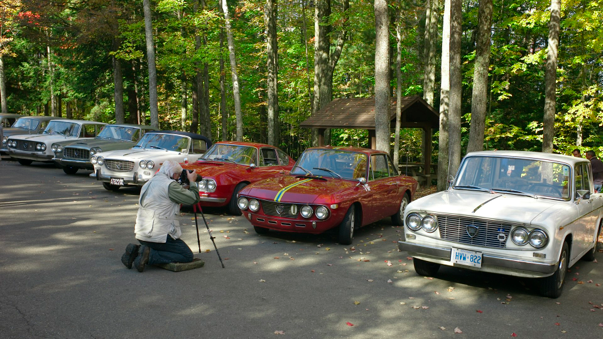
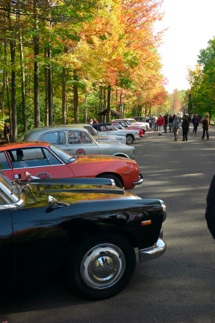
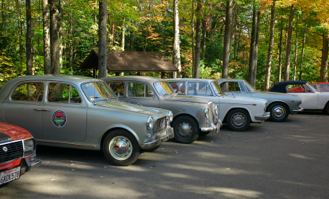

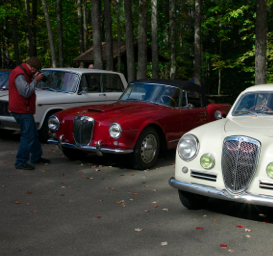


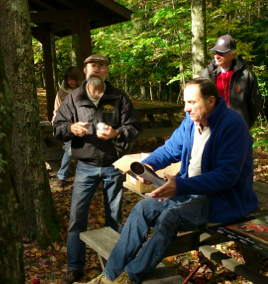
Walt Spak, organizer in chief – a great job!
Fulvia HF
Tireless Lancia 6 Appias and Fulvias
Tireless Lancia 6 crew – with pistons as prizes